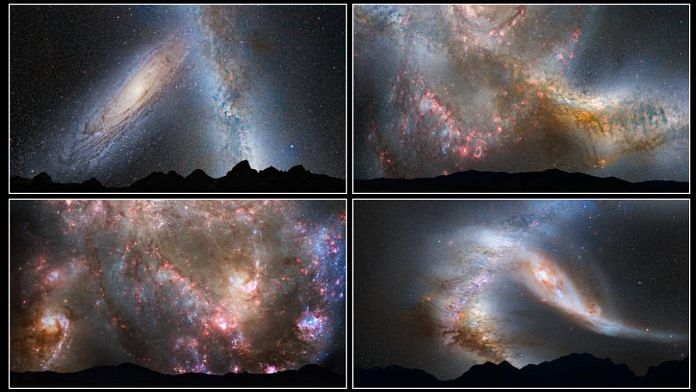Bengaluru: The Milky Way galaxy was expected to collide with the neighbouring Andromeda galaxy in five billion years. But now, the prediction has gone for a toss. A new study published in Nature Astronomy earlier this month says there is only a 50 percent chance of this happening even in the next 10 billion years.
“People have looked at the same problem before. But we have slightly newer data for all of the different observables,” Till Sawala, researcher at University of Helsinki in Finland and lead author of the study, told ThePrint.
Ten billion or even five billion years is a timescale the human mind cannot comprehend easily. The Earth itself is predicted to die in approximately one billion years. So, the impact of whether or not our Milky Way will collide with another galaxy may be inconsequential to humans.
“But it tells us that when you improve your technology, it in turn helps you to measure the distances. Then you can infer the orbital motion of these galaxies around each other,” said Sudhanshu Barway, associate professor at the Indian Institute of Astrophysics in Bengaluru. Barway was not part of the study.
Sawala’s team sifted through a new set of data from the European Space Agency’s Gaia telescope. It’s designed to conduct a galactic census by measuring precisely the positions and velocities of stars.
“Preliminary data from Gaia was already available in 2019. In 2021, there was the so-called Gaia Data Release 3, and that influences how we think the Andromeda moves,” Sawala added.
The researchers focused more on how Andromeda moves in a direction perpendicular to the Earth, rather than considering its motion towards the Earth.
Up until 2019, scientists had studied the interaction of the Milky Way and the two bodies closest to it, the Andromeda followed by the Triangulum Galaxy.
In this study, Sawala’s team also considered a fourth galaxy, Large Magellanic Cloud, to understand the combined effect of their interactions. According to Sawala, the previous research had neglected the fourth galaxy interaction due to its negligible mass.
New observations from the Gaia telescope, however, show that the Large Magellanic Cloud is quite massive.
A lot of uncertainties are expected while measuring the velocity and relative distances of galaxy masses. To account for this, the researchers ran many simulations, each with slightly different values for, say, Andromeda’s speed and Milky Way’s mass.
After many trials, they found only a 50 percent chance for our galaxy to collide with its neighbour.
“When you look at the statistics, if you have a smaller number of points (observations), your error on any prediction would be higher. But if you have a larger number of points, your… prediction would be slightly improved,” said Barway, adding that larger sample sizes lead to more accurate predictions.
“In the full system, we found that uncertainties in the present positions, motions and masses of all galaxies leave room for drastically different outcomes and a probability of close to 50 percent that there will be no Milky Way-Andromeda merger during the next 10 billion years,” states the study paper.
Possibly ‘boring’
Although a possible collision with Andromeda is far beyond in time, the structure of the star groups in the galaxy can change once they merge. Some stars can be thrown out of the system, while some may go into the merged galaxy.
Apart from the stars, there is a large amount of gas present in the galaxies, which can then basically lead to the formation of stars and the galaxy will pass through the various stages.
Now, the Milk Way takes the shape of a spiral with beautiful spiral arms courtesy the large amount of material present in the form of gas that births stars. Once a collision happens, the stars and the gas settle. “And then (the merged galaxy) becomes a very boring, featureless elliptical galaxy,” Barway explained.
Nonetheless, according to Sawala, there’s a motivation now to get even more precise measurements to understand how the galaxies will evolve.
“We also need to make more accurate models. This is something that I’m working on now with a PhD student, to create a more accurate, cosmological model,” Sawala said.
(Edited by Nida Fatima Siddiqui)
Also Read: Pune astronomers identify galaxy in Milky Way’s neighbourhood as ‘explosive factory’ of gamma rays






